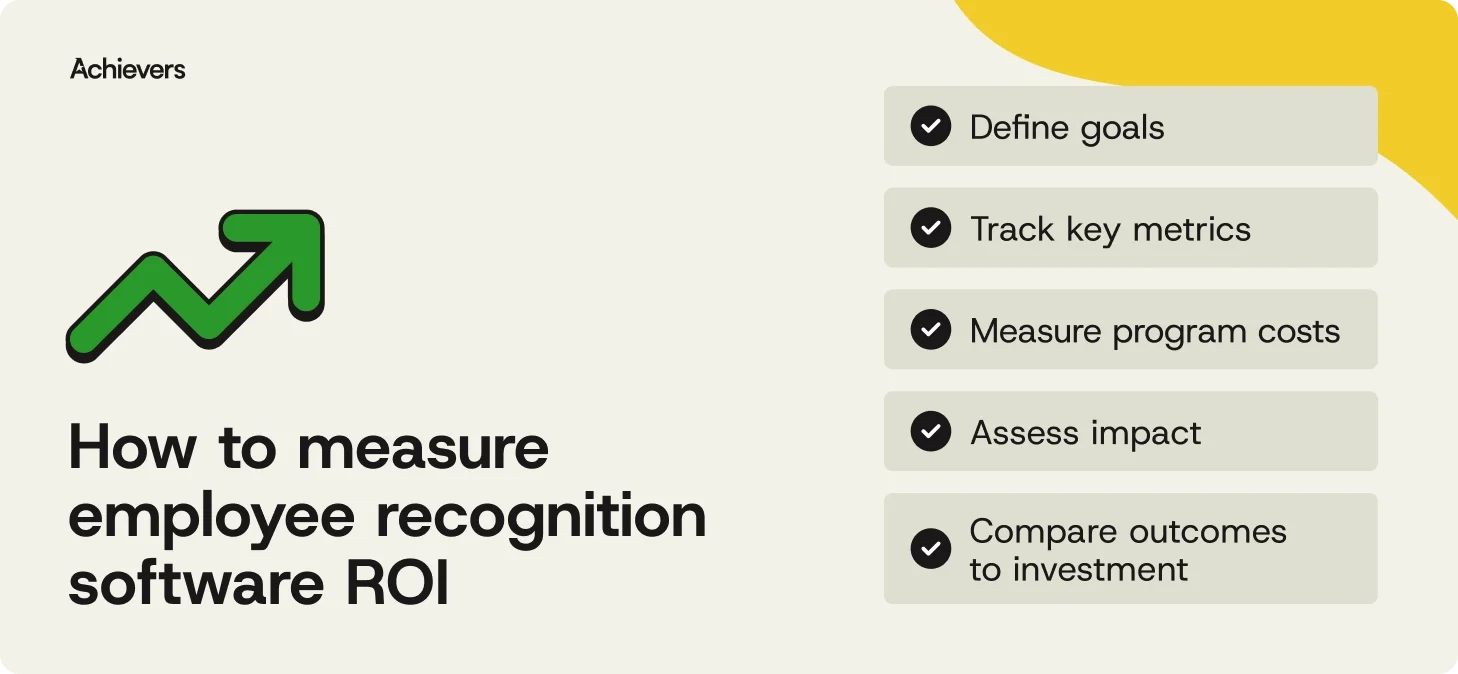Table of contents
Create a culture that means business™
Schedule a demo with an Achievers solution expert today.
Every HR investment should prove its worth — and recognition is no exception. Measuring an employee recognition software’s ROI helps leaders move from “feel-good” to fact-based, showing exactly how appreciation drives engagement, retention, and performance.
Still, 51% of HR leaders say they can’t measure the ROI of their HR technology investments. But the data’s already there — the State of Recognition Report found that employees recognized weekly are 2.6x more likely to be productive. So if recognition clearly works, why is it still so hard to measure?
This blog unpacks exactly that — how to measure recognition software ROI, the business outcomes that drive it, and what it looks like in action.
How does employee recognition impact ROI?
When people feel seen, they show up differently. That’s the real power behind recognition. Employee recognition doesn’t just drive ROI, it builds the behaviors that move your business forward. From retention to engagement, productivity to performance, the returns are easy to spot once you know what to look for.
Retention
Recognition is one of the most cost-effective ways to keep your best people. When appreciation is visible and consistent, it reinforces that sense of “I belong here” — the quiet force that keeps turnover low and loyalty high. Employees who feel recognized don’t have one foot out the door; they’re too busy leaning in.
Engagement
If you want engagement that shows up on the bottom line, start with recognition. It’s the bridge between effort and meaning — the moment work feels like contribution, not obligation. Employees recognized weekly are nine times more likely to feel a strong sense of belonging, according to the State of Recognition Report. That’s the true ROI of employee engagement — measurable, cultural, and contagious.
Productivity
People don’t do their best work because someone’s watching — they do it because someone noticed. Recognition reinforces what great looks like, turning everyday wins into habits worth repeating. The result? More focus, more energy, and fewer “Sunday scaries.” It’s productivity with purpose, not pressure.
Culture
Culture grows stronger every time recognition happens. When appreciation becomes part of daily work, values turn into actions, culture drives business goals, and belonging becomes the norm. It’s how purpose stops being a poster on the wall and starts becoming the way people actually work together.
How to measure the ROI of employee recognition software
ROI isn’t just about proving impact — it’s about knowing where it comes from. Measuring it means connecting the dots between everyday appreciation and the business outcomes that come after.
Here’s how to understand and measure ROI across your recognition and engagement strategy:

1. Define your goals
Start by naming the outcomes that matter most to your organization. Are you trying to improve employee turnover? Strengthen engagement? Boost productivity? Define those priorities early so recognition is tied to measurable impact — not just good intentions.
2. Track key metrics
Use data to tell the story. Track changes in turnover rates, eNPS, productivity, absenteeism, and customer satisfaction before and after implementing your recognition platform. Recognition data — the who, how often, and how loud — gives life to the numbers.
3. Measure program costs
Calculate your total investment, including software subscription, rewards budget, and administrative time saved. Recognition software quickly earns its keep — cutting out manual work, saving HR time, and making results easy to see.
4. Compare outcomes vs. investment
Translate your results into tangible business value. For instance, reduced turnover translates to direct cost savings; improved engagement drives higher productivity; better morale leads to stronger performance. When recognition is measured against business KPIs, the return often speaks for itself.
5. Assess cultural and people impacts
Some returns can’t be summed up in a spreadsheet — but they’re no less important. Track how recognition influences employees’ sense of belonging, leadership visibility, and value alignment. These insights help balance the quantitative with the qualitative — showing not just what changed, but why it changed.
The key business outcomes that drive recognition software’s ROI
Recognition software drives ROI by shaping behavior — and behavior drives performance. It’s not just about making people happier; it’s about creating the conditions where they want to give their best — and keep doing it.
Here’s how recognition ROI shows up in action:
Increased productivity
Recognition gives people clarity on what “great work” looks like — and motivation to repeat it. A quick “thank you” can do what a dozen dashboards can’t: remind someone their effort matters. Over time, that sense of visibility builds the kind of quiet momentum every high-performing team runs on.
Improved retention
Recognition is how you stop good people from wondering if they’d be appreciated somewhere else. According to the Engagement and Retention Report, employees who feel appreciated at work are twice as likely to see a long-term career at their company. That’s how you save on rehiring costs and keep your best people.
Higher engagement
Engagement doesn’t come from a survey — it comes from being seen. When recognition is regular, employees don’t just show up; they buy in. They trust their leaders more, collaborate more freely, and care a little deeper about the outcome.
Enhanced workplace culture
Culture grows stronger every time recognition happens. When recognition becomes part of daily life, values come to life too. Belonging stops being a concept and starts being a shared experience. And recognition keeps culture grounded in people, not posters.
Greater HR efficiency
Recognition software doesn’t just celebrate people — it saves people time. Automation takes care of the busywork, software integrations keep systems connected, and analytics show what’s working. The result? Less time managing programs, more time building impact.
Better customer satisfaction
How your people feel inside the company shapes how customers feel on the outside. Recognition creates a ripple effect — motivated employees deliver better service, show up with more empathy, and show up to work ready to innovate. It’s a ripple effect that reaches far beyond the organization — because happy teams create happy customers.
Turn ROI insights into your recognition strategy
Recognition data is only as powerful as what you do with it. The real return comes from connecting those insights to what the business actually cares about: performance, retention, and measurable impact. Here’s how:
Link recognition to business goals
Start by aligning recognition metrics with the outcomes leadership cares about most — retention, performance, engagement, and manager effectiveness. Recognition data can uncover which teams are thriving, where connection is fading, and how recognition influences results.
When recognition data maps directly to business goals, your return becomes easy to prove — and even easier to sustain.
Pair data with storytelling
Use recognition data to back up anecdotes from employees, leaders, or teams whose performance improved after feeling seen and appreciated. It turns your ROI conversation from a spreadsheet review into a story about transformation.
Use AI-powered analytics to fine-tune impact
AI can uncover patterns a dashboard might miss, like a department where recognition is quietly driving retention, or a team at risk of burnout at work because appreciation isn’t landing. It makes recognition more intentional — the right message, at the right moment, for the people who deserve it most.
Showcase ROI with outcomes that matter
Instead of just showing data, tell the story behind it. Show how recognition helped a team rebuild trust after a change, or how a leader used recognition to boost motivation during a tough quarter. Those moments make it real.
Keep measuring — and evolving
When you think of recognition or employee engagement, ROI should feel like a conversation that keeps going. Track what’s changing: recognition frequency, participation, engagement scores, sentiment. Then adjust and grow from there.
Real-world recognition ROI examples
It’s one thing to talk about recognition and ROI — it’s another to see what it does for business. These organizations partnered with Achievers to turn appreciation into performance.
General Motors (GM)
GM proved that when recognition feels genuine, the results follow. By partnering with Achievers to unite 160,000 employees through one global platform, GM made appreciation part of everyday work — and saw the payoff. Within 30 days, 87% of employees were active, and recognition quickly became a top driver of engagement company-wide — strengthening connection, reducing attrition risk, and proving that recognition pays off.
Sobeys
When Sobeys wanted to strengthen performance and connection across its retail network, it started with recognition. Sobeys worked with Achievers to create Bring It!, a gamified program that tied appreciation to business goals and friendly competition. The result? They boosted cube truck utilization from 77% to 86% across its retail support centers — showing how a well-designed recognition strategy can drive real, measurable results.
From employee recognition software to real ROI
The ROI on employee recognition is clear — value your people, and performance follows. Recognition turns connection into commitment, effort into impact, and culture into something you can actually measure.
The real wins happen when organizations move beyond counting clicks or kudos and start using recognition to change how people work together. It’s where data meets humanity — and where the ripple effects show up in engagement, retention, and results.
At Achievers, that’s what we do best. Our platform makes recognition easy to scale and even easier to measure — turning everyday appreciation into lasting business impact. Because when recognition works, so does everything else.
Employee recognition software ROI FAQs
Key insights
- Recognition fuels the everyday actions that improve performance, strengthen culture, and keep people engaged.
- Track metrics like turnover, engagement, and productivity to show exactly how recognition drives results.
- AI surfaces patterns and insights you might miss — helping recognition land where it matters most.
“If there’s no clear connection, proving value later will be an uphill battle.”
Brie Harvey
Head of Market Research and Community, Achievers



